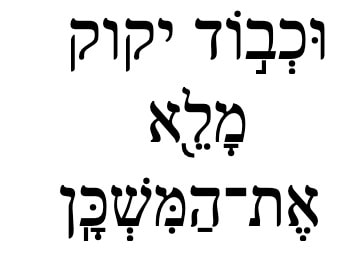 Rabbi David Etengoff Dedicated to the sacred memories of my mother, Miriam Tovah bat Aharon Hakohen, father-in-law, Levi ben Yitzhak, sister, Shulamit bat Menachem, sister-in-law, Ruchama Rivka Sondra bat Yechiel, Chana bat Shmuel, Yehonatan Binyamin ben Mordechai Meir Halevi, Shoshana Elka bat Avraham, Tikvah bat Rivka Perel, Peretz ben Chaim, Chaya Sarah bat Reb Yechezkel Shraga, Shmuel Yosef ben Reuven, Shayndel bat Mordechai Yehudah, the Kedoshim of Har Nof, Pittsburgh, and Jersey City, and the refuah shlaimah of Mordechai HaLevi ben Miriam Tovah, Yocheved Dafneh bat Dinah Zehavah, and the health and safety of our brothers and sisters in Israel and around the world. The term, “u’chvode Hashem,” is found twice in the context of the Mishkan: “The cloud covered the Communion Tent, and Hashem’s glory (u’chvode Hashem) filled the Tabernacle. Moshe could not come into the Communion Tent, since the cloud (anan) had rested on it, and Hashem’s glory (u’chvode Hashem) filled the Tabernacle.” (Sefer Shemot 40:34-35, translation, The Living Torah, Rabbi Aryeh Kaplan zatzal, with my emendations) In his Aramaic translation of the Torah on our pasukim, Onkelos (first-second century CE) renders u’chvode Hashem as, “vi’kara d’Hashem” (“and the honor of Hashem”), reminiscent of the celebrated verse in Megillat Esther, “And the Jews had light and happiness and gladness and honor--l’yehudim hayitah orah v’simchah v’sasone vi’kar.” (8:16, translation my own) What does u’chvode Hashem mean? Was it a mystical feeling engendered by being in proximity to the Almighty’s Presence, or something else entirely? While Rashi (1040-1105) is silent regarding the meaning of u’chvode Hashem in our pasukim, his brief gloss on Sefer Bamidbar 14:10, one of the five other pasukim containing this expression in Tanach, identifies u’chvode Hashem with the anan. In contrast, the Rambam (Maimonides, 1135-1204) in his philosophic magnum opus, Moreh HaNevuchim (Guide for the Perplexed) interprets our expression as: “... the created light (ha’or sh’nivra) that is designated as kavode in every passage [in Tanach] and that filled the tabernacle…” (I:19, translation, Dr. Shlomo Pines, page 46, brackets my own, and see as well, I:64) Rabbi Shlomo Ephraim ben Aaron Luntschitz (1550-1619), known as, “the Kli Yakar,” after the name of his commentary on the Torah, embraces the Rambam’s approach in his examination of our pasuk: It appears from this verse that kavode Hashem is not the same thing as “the anan.” Rather, the fire and the light, that is, kavode Hashem, was visible from the midst of the anan, for without the cloud it would have been impossible to gaze upon it. For if a person cannot look directly at the light of the sun, all the more so is it the case regarding the splendorous light of His Shechinah, may He be blessed. Therefore, this holy light was visible solely from inside the cloud. (Translation my own) We now have two ways of defining the nature of kavode Hashem: According to Rashi, it refers to the anan, whereas both the Rambam and the Kli Yakar associate it with some kind of Divine light; either “ha’or sh’nivra” (Rambam) or “the splendorous light of His Shechinah, may He be blessed” (Kli Yakar). These explications bring us closer to a more profound understanding of one of the most celebrated pasukim in our tefilot: “And one [of the Seraphim] called to the other and said, “Holy, holy, holy is the L-rd of Hosts; the whole earth is full of His glory (m’lo kol ha’aretz k’vodo).” (Sefer Yeshayahu 6:3, translation, The Judaica Press Tanach, brackets my own) May the time come soon, and in our days, when the entire Jewish people, and all humankind, will gaze upon the splendorous light of the Shechinah, and join the Seraphim in recognizing m’lo kol ha’aretz k’vodo. V’chane yihi ratzon. Shabbat Shalom Past drashot may be found at my blog-website: http://reparashathashavuah.org. Please contact me at [email protected] to be added to my weekly email list. *** My audio shiurim on the topics of Tefilah and Tanach may be found at: http://tinyurl.com/8hsdpyd *** I have posted 164 of Rabbi Soloveitchik’s English language audio shiurim (MP3 format) spanning the years 1958-1984. Please click on the highlighted link: The Rav
0 Comments
Leave a Reply. |
Details
Archives
July 2024
AuthorTalmid of Rabbi Soloveitchik zatzal Categories |
- Blog: Rabbi David Etengoff: Parashat HaShavuah
- Sefer Bereishit 5784&5785
- Sefer Shemot 5784&5785
- Sefer Vayikra 5784&5785
- Sefer Bamidbar 5784 &5785
- Sefer Bereishit 5782&5783
- Sefer Shemot 5782&5783
- Sefer Vayikra 5782&5783
- Sefer Bamidbar 5782&5783
- Sefer Devarim 5782&5783
- Sefer Bereishit 5780& 5781
- Sefer Shemot 5780&5781
- Sefer Vayikra 5780&5781
- Sefer Bamidbar 578&5781
- Sefer Devarim 578&5781
- Sefer Bereishit 5778&5779
- Sefer Shemot 5778&5779
- Sefer Vayikra 5778&5779
- Sefer Bamidbar 5778&5779
- Sefer Devarim 5778&5779
- Sefer Bereishit 5776&5777
- Sefer Bereishit 5774&5775
- Sefer Bereishit 5772&5773
- Sefer Bereishit 5771&5770
- Sefer Shemot 5776&5777
- Sefer Shemot 5774&5775
- Sefer Shemot 5772&5773
- Sefer Shemot 5771&5770
- Sefer Vayikra 5776&5777
- Sefer Vayikra 5774&5775
- Sefer Vayikra 5772&5773
- Sefer Vayikra 5771&5770
- Sefer Bamidbar 5776&5777
- Sefer Bamidbar 5774&5775
- Sefer Bamidbar 5772&5773
- Sefer Bamidbar 5771&5770
- Sefer Devarim 5776&5777
- Sefer Devarim 5774&5775
- Sefer Devarim 5772&5773
- Sefer Devarim 5771&5770
 RSS Feed
RSS Feed
